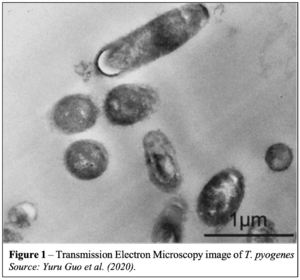Trueperella pyogenes
Classification
Domain: Bacteria; High Gram Positive Class; Actinobacteria Order; Actinomycetales Family; Actinomycetaceae
Species
Trueperella pyogenes
NCBI: [1] |
Trueperella
Description and Significance
Trueperella pyogenes is a gram positive bacteria which does not form spores, cannot move, is non-capsulated, and is a rod shape. This bacteria thrives in areas rich with blood and/or serum, which is often used to culture (Rzewuska, 1). For this reason, T. pyogenes is responsible for many types of infections including mastitis, pneumonia, and abscesses often found in livestock and humans.
Genome Structure
Trueperella pyogenes contains a single round chromosome with anywhere from 2.3-2.4 base pairs depending on the strain. This chromosome is circular, characteristic of its class of actinobacteria. This bacteria is unique because it is characterized by a high conentration of guanine and cytosine bases. A high concentration of guanine and cytosine bases indicates a high melting point (Tm) which is characteristic of pathogenetic bacteria. These types of bacteria need a high Tm in order to survive in a host, so bacteria with a high concentration of adenine and thymine would most likely not thrive in a mammal as a host. T. pyogenes also has a high number of pseudogenes, which are imperfect copies of an original gene (Rzewuska,1).
Cell Structure, Metabolism and Life Cycle
Trueperella pyogenes contains a complex fermentative metabolism that has the characteristic of high proteolytic tendencies. Proteolytic activity refers to the breakdown of proteins into their subunits, amino acids, through the use of enzymes. With cultures consisting of blood and/or serum, T. pyogenes has a strong tendency to form colonies thanks to these characteristics. NCBI states that many bacterium in the actinomycetaceae family have phosphotransferase systems responsible for the ability to form colonies, and thus, abscesses. T. pyogenes also produces the gene CbpA, which has a potential to reach collagen-rich tissues, like hooves (Rzewuska,1). Abscesses in livestock often occur in the hoof region (horses, cows, goats, etc..) which innermost portion consists of keratin and collagen, which T. pyogenes thrives in.
Ecology and Pathogenesis
Trueperella pyogenes thrives in cultures consisting of blood and serum for energy metabolism, so this bacteria thrives in humans and animals alike. As long as blood and serum are present in some way, this bacteria will survive, although it does seem to have a preference towards animals, particularly hooved animals. Livestock like horses, cattle, sheep, and goats are most affected, but other animals like camels, buffalo, gazelles, chickens, reindeer and turkeys are also affected. Infections in humans are infrequent, but potentially devastating. T. pyogenes is responsible for purulent infections like mastitis, pneumonia, abscesses and metritis. This bacteria is virulent, infectious, and pathogenetic, and does not infect plants. If livestock develops an abscess, there will be a pus pocket that is developed in the hoof region that will render the animal lame (causing it to limb) and express severe discomfort. Mastitis, or, the infection and inflammation of a mammillary gland (site of milk production) infection in livestock, particularly cows, is detrimental to their economical contribution (CABI, 2).
References
1. Rzewuska, M., Kwiecień, E., Chrobak-Chmiel, D., Kizerwetter-Świda, M., Stefańska, I., & Gieryńska, M. (2019, June 4). Pathogenicity and virulence of trueperella pyogenes: A Review. International journal of molecular sciences. Retrieved November 15, 2022, from https://www.ncbi.nlm.nih.gov/pmc/articles/PMC6600626/#:~:text=T.,breeding%2C%20generate%20significant%20economic%20losses. https://mechpath.com/2021/12/03/trueperella-pyogenes/
2. Invasive Species Compendium . Trueperella pyogenes infections. (n.d.). Retrieved November 15, 2022, from https://www.cabi.org/isc/datasheet/93454#tooverview
Author
Page authored by Elan Doyle, student of Prof. Bradley Tolar at UNC Wilmington.

